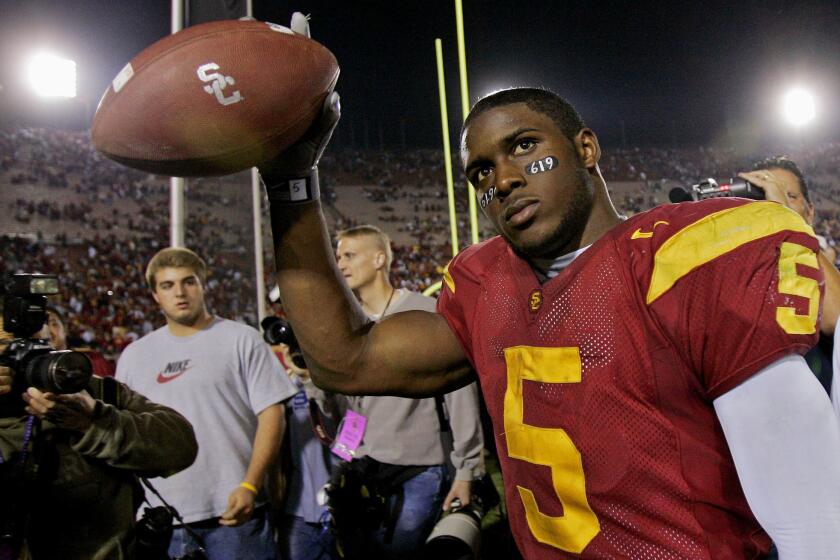Cardinals’ Patrick Peterson creates a no-fly zone for opponents

For opposing quarterbacks, waiting for a receiver to create separation from Arizona Cardinals cornerback Patrick Peterson is a little like staring into the unfiltered desert sun.
Don’t bother. It’s a waste of time, and likely will result in pain.
Peterson, in his sixth season, is a quintessential shutdown corner, routinely assigned to the opposition’s best receiver. He made the Pro Bowl in each of his first five seasons — once as a kick returner, four times as a corner — and joins Hall of Famers Jim Brown, Barry Sanders and Emmitt Smith as the only players in NFL history to make five Pro Bowls before their 26th birthday. He’s the only defensive player to do so.
“He would be a top-five receiver in the league,” Coach Bruce Arians said of Peterson, 26. “He’s just natural. Unbelievable one-handed catches. He gets in the quarterback drills and does the bucket toss in the end zone every Friday. He’s just a freaky athlete.”
When passers get bold, Peterson frequently makes them pay. He has 17 interceptions since the Cardinals made him the No. 5 pick in 2011, the league’s fourth-most during that span. Seattle’s Richard Sherman leads that list with 26, followed by a pair of Oakland Raiders: Reggie Nelson (21) and the now-retired Charles Woodson (18).
Peterson essentially turns half the field into a no-fly zone.
“It can be kind of boring for him because quarterbacks don’t even look his way,” safety Tony Jefferson said. “We already know that side of the field is locked down.”
There’s some irony in that the better he is at his job, the more Peterson goes under the radar because the ball simply isn’t coming his way.
“It’s tough,” he said. “But at the end of the day, I’m doing what the defensive coordinator expects me to do, and that’s go out there and take the opposing team’s No. 1 receiver off the stat sheet. At times, my position can be glorified, but nine times out of 10 it isn’t. My great work goes unnoticed and is silenced. Opportunities for me to make plays are very slim.”
Arians said Peterson “allows you to do things that other guys don’t let you do — it’s, ‘You have [Dallas receiver] Dez Bryant,’ or, ‘You have [Atlanta’s] Julio Jones...’
“We do blend in zone coverage, so it’s not 65 plays of that. But that means the second corner is getting the balls, so you know they’re going over there all day. So you can game plan a little bit, with help, because you don’t have to cover for Pat.”
As Arians has told the collection of corners who have rotated into that second spot, they’re either going to get lots of welcome exposure — half of the Cardinals’ first eight games are in prime time — or they’ll get exposed.
The Cardinals, who went 13-3 last season, are in the unfamiliar position of a vogue Super Bowl pick. They had the league’s top-ranked offense last season, a group led by veteran quarterback Carson Palmer and receiver Larry Fitzgerald, but with a youth infusion that includes running back David Johnson, along with speedy (and unrelated) receivers Jaron Brown and John Brown, and the sure-handed Michael Floyd.
Every player who gained an offensive yard or scored a point for Arizona in 2015 is back this season.
The big changes have come on defense, with the team beefing up its pass rush by adding outside linebacker Chandler Jones, acquired in a trade with New England, and first-round pick Robert Nkemdiche, considered by some the best defensive lineman in the draft but who fell because of character concerns.
By cranking up the pressure on quarterbacks, the Cardinals hope to force more faulty decisions, including less-than-pinpoint passes into the thick of a defense that last season finished fifth in yards allowed at 321.7.
“The ball definitely has to come out quicker, and it’s going to enhance our defense,” Peterson said of Arizona’s newfound ability to apply pressure with its base defense instead of needing to get more exotic.
“I’m not going to say we were one-dimensional, but teams knew what we were going to do seven out of 10 times. They knew we were a blitzing team, they knew we were going to bring the house. But now we can keep those guys on their heels more and keep them guessing.”
Peterson said if he and the rest of the secondary can do their jobs and cover receivers for at least 2.5 seconds, his teammates up front will have ample time to get to the quarterback.
If Peterson does that, he’s not likely to see the ball coming his way. He’s learned to live with the boredom.
Follow Sam Farmer on Twitter @LATimesFarmer
More to Read
Get our high school sports newsletter
Prep Rally is devoted to the SoCal high school sports experience, bringing you scores, stories and a behind-the-scenes look at what makes prep sports so popular.
You may occasionally receive promotional content from the Los Angeles Times.







